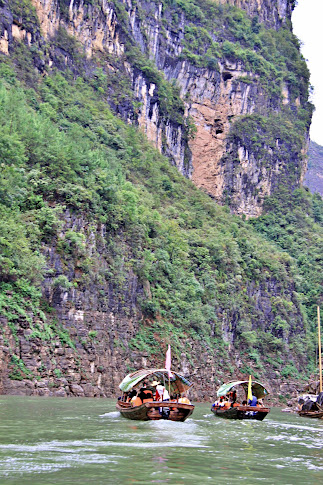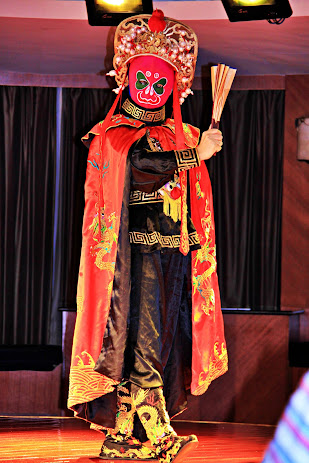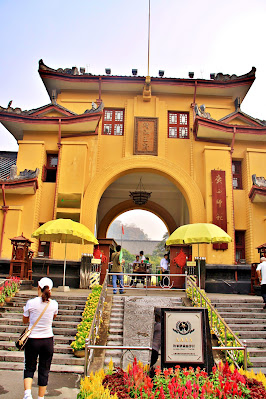Region Where Minority is the Majority. Strong As Zhuang.
Our first stop this morning is a ethnic cultural theme park. This kinda ethnic park almost always included in a Guangxi province tour package. After all, Guangxi official name is Guangxi Zhang Autonomous Region. China has 5 autonomous regions.
 |
All yellow shaded provinces are autonomous regions
with Guanxi (where Guilin is located) being the southernmost |
A casual glance at the map of China would have detected that all these autonomous regions are on the landlocked fringes of China, bordering with other countries, naturally. Because once upon a time, some of them were other countries. Except for Ningxia, which in a sense borders with another country as Inner Mongolia was not part of China before Gengis Khan.
Another Chinese ethnic minority was the Manchu (or Manchurian) who ruled China, and are absorbed into China like Inner Mongolia. Where's Manchuria Autonomous Region? The Manchuria 'autonomous region' is composed of three dumplings-eating provinces that sits at the north east corner of China, which border Inner Mongolia, Russia, and Korea. It's a cultural diverse region.
Another province that inhabited by a large population of ethnic minority group is Yunnan and it borders with Thailand, Myama, Loas and Vietnam. So why Yunnan and the provinces in the north east most of China aren't autonomous regions? They should be. But they are not. I could only speculate that it's due to the complex Chinese historical and political background. With the Manchu, its people and culture are being assimilated into China. Or to be precise, when the Manchus conquered China, they desperately wanted to be integrated themselves into Chinese culture to bring harmony (and to avoid rebellion) to the Qing Dynasty (and the policy worked out well).
Think of Catherine The Great who was a German princess. In the funny days of old, she didn't have to learn Russian to rule Russia. But she chose to teach herself the Russian language, and even joined the Russian Orthodox Church to go an extra mile to show her faith (in God and country). This won her brownie points with the Russian people.
Where was I? Oh yeah, back to Yangshou Guangxi. This ethnic cultural park, Peach Blossom Garden (桃花源), showcases the cultural architectures, artefacts and peoples of various major ethnic minority groups in Guangxi. If you ask me, I would prefer to see one real ethnic village than a dozen ethnic tourist display villages. I think the name for this park in the similar westerner tour packages might have been called "Peach Blossom Shangri-la", but I'm not sure.
Just like my yesterday's trip to
Fengyu Cave, and
Silver Cave the day before that, the passing scenery on our way there is as good as the destination, if not better. Below is a small sample.
In fact, yesterday, i visited the
Yao minority in Fengyu Cave. So the Autonomous Region of Guangxi has a share share of minority communities.

As we were free to explore the park, the tour guide didn't accompany us to do running commentaries (like a tennis match). So we were left clueless about the various minority groups roaming around the park. I took this photo and left to my own device to find out who these lovely gals were. The research can be a formidable task when you considering how many minority groups there are in China. Officially there 55 minority groups in China,
give or take. This number is a very broad stroke, and the actually number can be a lot higher depending on the classification criteria.
 |
| Sailing into the Crown Cave |
 |
Is this the peach blossoms that give this place its name?
probably not as it's not the right season... |
Take Taiwan, it has approx 26 known Taiwanese Aborigines languages, which implies the Formosa Island has at least 26 ethnic groups, and the number should likely be higher. But PRC government count all Taiwanese Aborigines as one group. Think of a country like Vietnam, which has only a fraction the size of China has recognized 54 distinct ethnic groups. Some of the groups like the Yao that you met in my last diary entry, and the Miao, etc live in both countries. If Chinese authority sorts its ethnic groupings the way the Vietnamese or Taiwanese government does, the figure would get bumped up several times over. Indeed, there are many sub-divisions within the Yao people that Chinese authority simply lumps them into as one. Maybe it's a good thing because the diversity simply boggles the mind.
 |
| Some stage performance as we glided along the river |
Undaunted, I thought I do the research by narrowly the research with some deliberation. First, not all ethnic minorities in China live in Guangxi. Duh. Even then, there still left with quite a number of minority groups (probably more than 20). I further narrowed it to the largest and most familiar groups - the Zhuangs (壮族), Yaos (瑶族), Miaos (苗族), and Dongs (侗族). I actually heard about the Miao people of Vietnam way back when I was still in my primary school in Vietnam, but didn't know that they also live in China. Starting with my first search of Zhuang, I hit the jackpot right away - I was able to identify costumes of the girls in the photo as the Zhuang people. After all, the official name for this province is "Guangxi
Zhuang Autonomous Region". The Zhuang is not only the largest group in this province, but in fact, the largest in China - some 16 millions strong (Zhuang = 'Strong' in Chinese).
Most minorities have very colourful and flamboyant costumes, the Zhuang traditional dresses are quite simple, typically black and blue. The top looks like a top half of a short-sleeved qipao that are ever so popular in the West.

The unique wooden architecture is the famous Drum Tower of the
Dong people. If you have already read my diary entry on "Guilin - Day 2", you would have thought this is a Yao costume (with slight variation), but in fact a Dong costume. That's the thing about this sort of ethnic park, there're different ethnic people walking around different places leaving the tourists like me can't make heads or tails - actually Yaos or Dongs - out of this place. This tower has 5 tiers of roofs, some have many more - as many as 20.
We headed for
yet another cave in the arvo. 3 caves in 3 days in a row. I have never been so caved out, especially that I'm not a cave man - I mean a cave person (a civilised cave man). Don't bore me with another set of calcium carbonate formations, I said to myself. This one called the Crown Cave. Having seen Silver Cave 2 days ago, it takes a great deal to win me over.
The Crown Cave didn't top Silver Cave, but it has its own charm. I wasn't as disappointed as I have with Fengyu Cave that I went yesterday. Instead of trekking the cave in more or less horizontally, we ascend as we proceed deep into the cave. As we entered the cave's centre piece, standing at the bottom, the steep stairs led our eyes skyward towards the tall and impressive limestone columns on top of the stairs. It reached the top of a very high cave ceiling, with its limestones structures adorn the columns like intricate, exquisite carvings of some Renaissance genius sculptors. For an European, this probably reminds them of a cathedral with soaring columns and vaults. To me, it looks almost
exactly like the underwater palace of the Dragon King of the East Sea (東海龍王) that I remember from Chinese movies. Quite spooky and stunning.
 |
| Embroidery session |
We finished the night with the watching of "Impression Liu Sanjie" ("Liu's 3rd Sister" 刘三姐). The show takes place in the open with the backdrop of the picturesque Guilin limestone karsts. The 'stage' is an inlet surrounded by seven limestone hills. Because it takes place at night, several karsts were light up with flood lights. They took on an eerily magical and translucent quality - imagine shine a torch light onto your face from below your chin in the dark. Yep, that same eerily ambience of a ghost story telling writ large provides the backdrop for the show. Most of the dancers perform in water, and I was told they do this all year round. My guide told me that one of his Harbin tourist member told him that winter here is colder than Harbin - the famous City of Ice Festival in the North (in 'Manchuria'). I find it hard to swallow, but what is even more incredible is that the actors do their performances in water scantily clad. Many performers are fishermen by day, which explains their constitution of an ox that we mere mortals can only admire them from afar in quiet awe, followed by some loud applause. As impressive as these feats of physical endurance, these kinda things come natural to them, what is impressive is asking the farmers and fishermen to turn into performers, which is not something that come natural to them. Isn't this the developing story of China today? While China is trying to turn farmers into factory hands, Zhang turn them into stage performers.
Because the show was done in open air, the audience is susceptible to weather elements and other not so pleasant random Acts of God. It showered before the show started and we were given raincoats at the entrance. Our spirits weren't dampened. Our guide cheered us up by saying that the light rain adds atmosphere. He wasn't too far off the mark.
This show was created and directed by the ever so popular Zhang Yimou. Anyone who had sampled his movies and watched the 2008 Beijing Opening Ceremony last year knows about his handiworks. I watched the Opening Ceremony and nearly all his subsequent movies starting from "Raise The Red Lantern" (Gong Li gave a commanding performance), which introduced me to his cinemas. So I held high expectation of this show, and it was was met with resounding success; it delivered one visually stunning images after another of the highest caliber. Stylish, visual poetry. You don't have to be a part-time stock photographer turned casual shutterbug like me to appreciate the sumptuous feast for the eyes, and an awe matched only by the physical fortitude of the performers. Not surprisingly it was photography that save Zhang from slipping into oblivion. Truth be told, as a short-attention-span movie watcher, I found the absence of narrative a bit slow going. But this is just me, and it also explains my general boredom with staged performances of several kinds. Overall, the show is a must-see (despite my attention deficit). If you can stay focus, the performance is quite captivating and magical, the atmosphere dreamy, transporting you to another world. It costs $50 SGD/AUD if my memory serves. It's a China price.
This Chinese tourist operator website should offer clues on what I was talking about. Open the images on the left hand side of the webpage to get a better view.
http://www.yxlsj.com/chinese/dt_first.asp?id=媒体Zhang also created 3 other similar shows at 3 other Chinese tourist icons. According to the guide, "Impression Liu Sanjie" is the first and still the best. This show reminds me of the Light and Sound show at the Pyramid of Giza. Perhaps, Zhang got the idea from there. The Pyramid and the Sphinx was light up with multicolored light and given it that translucent feel, not dissimilar to the limestone karst. The light-up of these Egyptian icons was spectacular and impressive, but the rest of the 'show' consisted of a giant video screen showing some dramatised doco. This part is a bit passe and when compare the Liu Sanjie performances, it's quite lame. The narrator of the video sounded too 1930's with its over-the-top theatrical voice. Sorry! It was quite embarrassing. Replace the narrator with a Shakespearean actor and it would tone down its theatrical decibels by a few notches. Providing some live performances like Impression Liu Sanjie would have been better. Of course, you don't go to Egypt to see this lame show. But as some world tourism official suggest, if there's one show you should fly there to see, it would be "Impression Liu Sanjie". I wouldn't. But then stage performance isn't my cup of tea.














































